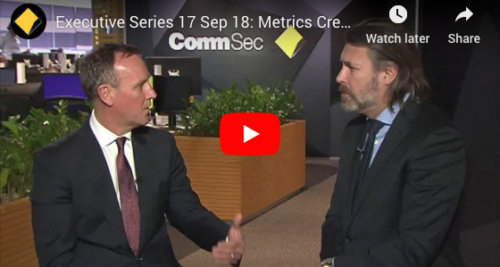Flexible, liquid assets ideally suited to a rising rate environment
Given that achieving financial freedom is usually the goal of any retail investment portfolio, locking your money away for years at a time is a troubling proposition for many. Fixed income, rightly or wrongly, is often characterised as illiquid, very long-term with only middling returns at best.
But as Metrics Credit Partners’ Andrew Lockhart explained in a recent interview, his sphere of private debt isn’t like that. He discusses the floating-rate assets of non-bank loans and how this affects their risk and return profile, explaining why such features are particularly appealing in an environment of potentially rising interest rates and rising inflation.
Detailing the process his team follows in identifying good lending prospects, originating the transactions and monitoring these over the life of the loan, it’s far from a set-and-forget process. Lockhart rejects the common assertion that illiquidity and complexity are drivers of returns in the asset class and outlines how manager skill and direct origination of transactions is the key to delivering attractive investor outcomes.
We seek to build long term relationships with our borrower clients and provide a high level of service to these clients. This translates into attractive investment opportunities for our investors” Lockhart says.
In the following wire, he provides insights on non-bank lending as an asset class, discusses how it compares to traditional bank-issued credit, details the key risks and how his team mitigate them, and how they’ve selected the more than 200 borrowers that comprise the portfolio.
When interest rates rise, how does private debt respond versus some other areas of fixed income?
Most of our loans are based on a floating market rate. So, if markets form the view that interest rates are going to rise, even before official movements by the RBA, that will flow through in terms of higher total pricing.
Metrics operates in a bank dominated market and we work with and compete against the banks to provide funding to Australian companies. To the extent you get rising interest rates, the banks’ cost to finance their own portfolios increases and this increased cost of funding flows through to wider credit spreads overtime. These wider credit spreads are charged to borrowers.
The floating rate, short duration and other characteristics of our loan assets means the total returns tend to rise in this market environment.
Other types of fixed income asset classes often lock investors in for longer periods on fixed interest rates, which means they can lose capital value and don’t participate in the rising income.
Floating rate assets can preserve capital because the underlying asset remains stable while total return increases in line with rising market rates.
Are there any other reasons why you believe non-bank lending is so well suited to the environment we’re currently heading into?
This asset class appeals primarily to people who want to protect their capital from volatility. If you think about a retiree, they don’t know how long they’re going to live – so there’s “longevity risk”. They also don’t want to see drawdowns on their capital, so they need capital preservation and stability of capital but also need to generate income.
When you’ve got deposit rates so low and traditional fixed income assets yielding such low returns, people look for alternatives. One of the features of private debt is that we’re involved in is that we’re originating the transactions directly with the companies.
The return to an investor is comprised of part fee income and part credit spread over and above the market base rate. Loans are generally priced off BBSY (bank bill swap bid rate) then to that, you add a margin. Depending on the risk of the transaction, that would drive the total return. You also charge the borrower an upfront fee or establishment fee for the work involved in providing the loan.
A higher-risk transaction should result in a higher credit spread or margin being charged to the borrower. On the other hand, an investment-grade borrower would be charged a lower margin.
Most Australian companies don’t have credit ratings and so are unable to access bond markets. Most bond managers tend to invest in financial institutions and in government and semi-government bonds.
There’s no diversity in the Australian corporate bond market because most debt financing is provided by banks.
Banks have increasing regulatory pressure, potentially making it less appealing for them to provide funding to companies. That creates a gap, which means the market needs to find an alternative means to finance corporates.
Non-bank lending appeals to investors because it offers genuine ways to protect and preserve capital and provides an attractive alternative source of income. We negotiate terms and conditions, impose covenants over a company, and take security, which are all ways we seek to mitigate risk. When we provide financing to a company, our job is to ensure we’re not at risk of losing money. That immediately flows through to an investor in the form of capital preservation.
Because we originate the transaction directly, we can capture a higher return in terms of fees charged to borrowers which is income to investors.
Traditional bond managers buy and sell over a screen trading securities. They’re not originating the bond opportunity; they’re not involved in structuring or pricing the transaction.
So often the bond market investor is more concerned about macroeconomic conditions, rates, and potential change ranges in credit ratings that might have an impact on the valuation of the bond instead of the fundamentals of what drives the cash flow and the return of the company, which affect its debt servicing and repayment.
Private debt is an attractive asset class in all environments, and particularly where you’ve got a view that interest rates are rising. Floating rate loans provide a hedge against inflation and the RBA reaction of lifting rates to curtail demand.
How do you determine which loans will make it onto your book and those that won’t?
The two areas that are most concerning to us as a lender are cash generation, and whether this delivers sufficient cash flow to service and repay the debt. We assess the value and makeup of the capital structure to determine how much risk is being born by shareholders, equity, and other subordinated layers of capital.
We then work out where we want to sit in that capital structure, which requires a lot of assessment around the industry risk and the management team.
We also look at macroeconomic effects on the industry and the individual company in building a deep understanding of what drives the cash flow. We rate and assess all the various risk factors to determine a credit rating.
Once we’ve established a credit rating on a company, we determine the risk of that loan and then price it appropriately.
What are the biggest risks for this asset class?
It’s often said that the drivers of return in private debt is illiquidity or complexity, but I don’t agree with that. My view is that it comes down to the manager’s skill set.
So, as a lender, what I want to be able to do is to build a relationship with a company to provide a high level of service whereby price and those sorts of issues are less relevant. At the end of it, you’re adding value to the company in terms of the way you structure or provide the funding. We seek to deliver a high level of service for our borrowers which is also valued.
The biggest risk is credit loss. For example, those who invested in the Virgin bond (in mid-2020) had no access to management, no information to assess risk. It was widely held by a very fragmented investor base. There was no means for them to corral power in the negotiation.
As a lender, we lend with other lenders or banks in a syndicate or we are the sole provider of that funding. The size and scale of our funds allows us to have real negotiating power, combined with access to information, allows us to better manage risk.
As a lender, we can compel a company to stop paying dividends, for example. We can also require any asset sales to pay down debt as a priority.
If credit quality deteriorates, we can also restructure the capital of the company. For example, out of $50 million of value, you might restructure the company and hold $25 million of debt, and $25 million equity. If the company or the project then performs in subsequent periods, because you’re holding the equity interest, you’ve got the right to participate in that upside.
Or as a lender, you might say, “Okay, we’ll provide funding to this company on the basis that we also get warrants, options or a profit share.” You don’t have to just simply get a return based on the debt that you’re providing. There are other ways we can negotiate an economic outcome.
As a lender, our analysis will create a base case scenario. And from that, we determine a range of scenarios or sensitivities based on our analysis of the cash flow.
If the quality of earnings deteriorate, or the performance of the company deteriorates, our stress tests and downside analysis helps us be sure it can still service and repay the debt, even under a period of stress or deterioration.
Then we set covenants and a capital structure based on a conservative view of what we believe the debt service capacity is based on macroeconomic risks or the financial performance of the company. We then monitor that risk.
Some companies report to us monthly, others quarterly, half-yearly, or annually. It’s not like you buy a five-year piece of paper and take the complete macroeconomic risk. We manage the risk on a day-to-day basis and are always setting our forecast and monitoring the performance of the companies we lend to. Our investment committee stress tests our activities on a weekly basis.
Other News
Metrics Credit Partners Completes Acquisition of Taurus and BC Invest
Metrics Credit Partners (“Metrics”), a leading Australian based alternative asset management firm, has today successfully completed the acquisition of Taurus…
Graham McNamara to Retire as Managing Partner
Metrics Credit Partners (“Metrics”) today announced that Managing Partner Graham McNamara has advised the Board of his intention to retire,…
INSIGHTS
MCP Income Opportunities Trust (MOT) lists on ASX
Sydney, 29 April 2019: The Trust Company (RE Services) Limited (ABN 45 003 278 831) (Responsible Entity) is the responsible…
MCP Master Income Trust wins Lonsec Listed Fund Award
The award came a year after MXT was listed on the Australian Securities Exchange






